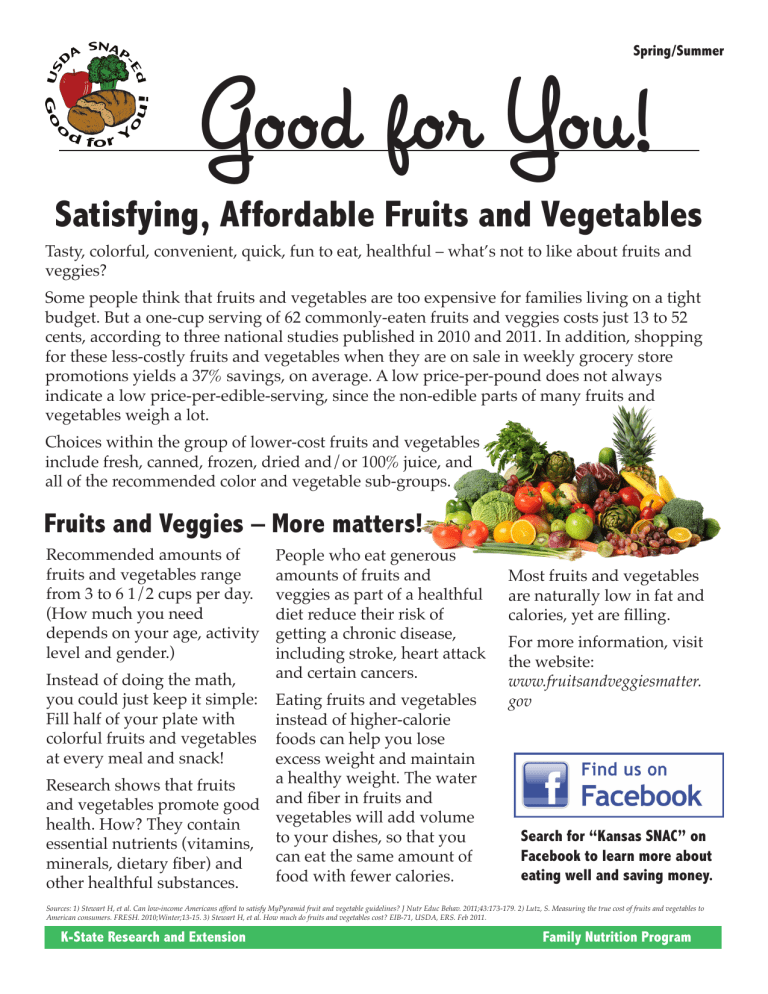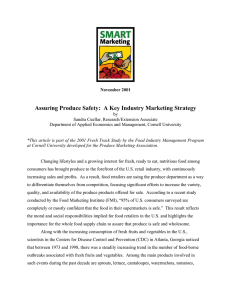Good for You! Satisfying, Affordable Fruits and Vegetables

Good for You!
Spring/Summer
Satisfying, Affordable Fruits and Vegetables
Tasty, colorful, convenient, quick, fun to eat, healthful – what’s not to like about fruits and veggies?
Some people think that fruits and vegetables are too expensive for families living on a tight budget. But a one-cup serving of 62 commonly-eaten fruits and veggies costs just 13 to 52 cents, according to three national studies published in 2010 and 2011. In addition, shopping for these less-costly fruits and vegetables when they are on sale in weekly grocery store promotions yields a 37% savings, on average. A low price-per-pound does not always indicate a low price-per-edible-serving, since the non-edible parts of many fruits and vegetables weigh a lot.
Choices within the group of lower-cost fruits and vegetables include fresh, canned, frozen, dried and/or 100% juice, and all of the recommended color and vegetable sub-groups.
Fruits and Veggies – More matters!
Recommended amounts of fruits and vegetables range from 3 to 6 1/2 cups per day.
(How much you need depends on your age, activity level and gender.)
Instead of doing the math, you could just keep it simple:
Fill half of your plate with colorful fruits and vegetables at every meal and snack!
Research shows that fruits and vegetables promote good health. How? They contain essential nutrients (vitamins, minerals, dietary fiber) and other healthful substances.
People who eat generous amounts of fruits and veggies as part of a healthful diet reduce their risk of getting a chronic disease, including stroke, heart attack and certain cancers.
Eating fruits and vegetables instead of higher-calorie foods can help you lose excess weight and maintain a healthy weight. The water and fiber in fruits and vegetables will add volume to your dishes, so that you can eat the same amount of food with fewer calories.
Most fruits and vegetables are naturally low in fat and calories, yet are filling.
For more information, visit the website: www.fruitsandveggiesmatter.
gov
Search for “Kansas SNAC” on
Facebook to learn more about eating well and saving money.
Sources: 1) Stewart H, et al. Can low-income Americans afford to satisfy MyPyramid fruit and vegetable guidelines? J Nutr Educ Behav. 2011;43:173-179. 2) Lutz, S. Measuring the true cost of fruits and vegetables to
American consumers. FRESH. 2010;Winter;13-15. 3) Stewart H, et al. How much do fruits and vegetables cost? EIB-71, USDA, ERS. Feb 2011.
K-State and
Get More Value
With Your Food
Dollars
To fill half of your plate with colorful fruits and vegetables at breakfast, lunch, supper and snacks, plan to spend almost half of your food budget on fruits and veggies, too. One way to free up money for buying more fruits and vegetables is to spend less for other foods. How? l Prepare meals and snacks at home. Buy few, if any, away-from-home foods, such as prepared restaurant foods and vending machine foods.
(This will save about onethird of the food budget of the average low-income U.S. household.) l Prepare meals and snacks from basic foods. Buy few, if any, expensive pre-cut, ready-to-eat or ready-to-heat meals and snacks. (This will save about 12% of the food budget.) l amounts that you can use before they spoil. (This will save about 10% of the food l
Buy foods only in the budget.)
Buy less, if any, sports drinks, energy drinks, carbonated beverages, coffee or alcohol. (This will save about 7% of the food budget.)
37 Least-expensive Veggies
(range = 13 to 48 cents per
one-cup-equivalent serving)
25 Least-expensive Fruits
(range = 17 to 52 cents per
one-cup-equivalent serving)
Boiled pinto beans, from dried
Boiled lentils, from dried
Boiled great northern beans,
from dried
Boiled black beans, from dried
Boiled navy beans, from dried
Boiled potatoes, from fresh
Boiled red kidney beans, from
dried
Boiled lima beans, from dried
Fresh whole carrots
Fresh iceberg lettuce heads 1
Boiled cabbage, from fresh
Fresh onions
Canned sauerkraut
Fresh cauliflower heads
Boiled whole carrots
Fresh celery stalks
Canned sliced carrots
Canned cut green beans
Frozen cut green beans
Canned whole kernel sweet corn
Canned pinto or red kidney
beans
Frozen carrots
Fresh baby carrots
Canned turnip greens
Fresh Romaine lettuce hearts 1
Boiled cauliflower, from fresh
head
Canned great northern beans
Canned whole or cut tomatoes
Fresh radishes
Canned potatoes
Frozen French fries
Canned mustard greens
Boiled sweet potatoes, from
fresh
Canned green peas
Canned black beans
Canned navy beans
Frozen kale
1 One-cup-equivalent of fresh lettuce is a 2 cup serving
Fresh watermelon
Apple juice*
Fresh bananas
Pineapple juice*
Grape juice*
Orange juice*
Apple juice, ready to drink
Grapefruit juice*
Fresh apples
Fresh navel oranges
Orange juice, ready to drink
Grape juice, ready to drink
Grapefruit juice, ready to drink
Pineapple juice, ready to drink
Raisins 1
Fresh pears
Fresh honeydew melon
Applesauce
Fresh plums
Fresh nectarines
Canned pineapple
Dried apples 1
Dried apricots 1
Dried cranberries 1
Dried plums / prunes 1
1 One-cup-equivalent of dried fruit is a 1/2 cup serving
* Frozen concentrated
100% juice reconstituted
at home
This material is funded by USDA SNAP.
USDA is an equal opportunity employer and provider. SNAP provides food assistance to people with low income. It can help you buy nutritious foods for a better diet.
For information, call 1-888-369-4777.
For more information, contact your local Extension Office



